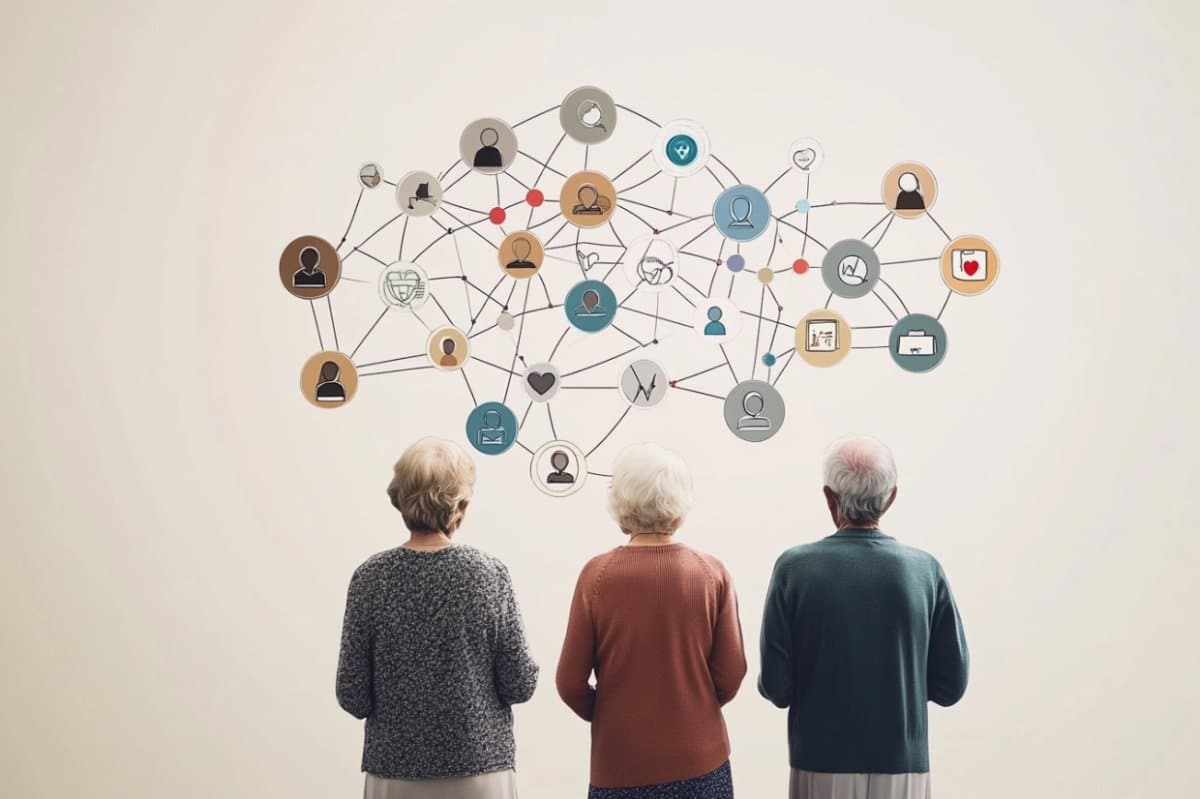Summary: A decade-long study of over 1,500 older adults reveals that socially enriched networks, marked by diverse and active relationships, are strongly linked to better health outcomes later in life. In contrast, those with restricted networks, often limited to family and shaped by isolation, reported significantly worse health and were less likely to improve their social ties over time.
Focused networks offered emotional closeness but lacked the health benefits of broader connection. Encouragingly, some individuals transitioned into more enriched networks, suggesting social mobility is possible with the right support.
Key Facts:
- Health Disparities: Older adults in restricted networks had the poorest health outcomes.
- Social Mobility: Over 40% of individuals in focused networks moved into enriched ones.
- Structural Barriers: Women, people of color, and the oldest adults were most at risk of social network decline.
Source: University of Illinois
A new study sheds light on the powerful connection between social networks and health in later life and reveals a surprising path for improving health equity among older adults.
Published in the journal Innovation in Aging, the study tracked over 1,500 older adults for a decade using three rounds of data from the National Social Life, Health and Aging Project.

Led by Lissette Piedra, a professor of social work at the University of Illinois Urbana-Champaign; and James Iveniuk, a senior research scientist at the University of Chicago’s National Opinion Research Center; the team identified three types of social networks — enriched, focused and restricted — that reflected how socially connected people were as they aged.
People in enriched networks — those marked by diverse, active relationships — reported the highest levels of self-rated health, a measure strongly associated with overall well-being.
Those in restricted networks — smaller, more isolated groups centered on family — reported significantly poorer health. Focused networks fell in between, providing emotional support but with limited breadth.
Individuals in the restricted group reported significantly poorer health at the beginning of the study. However, by the end, both those in the restricted and the focused groups showed worse health outcomes than people in the enriched group, though the differences had narrowed, according to the study.
“Social isolation and loneliness can have corrosive effects on mental and physical health,” said Piedra, who is also a professor of Latina/Latino Studies.
“Older adults’ social circles may shrink due to poor health, loss of loved ones, poverty, discrimination, language barriers or living in rural or unsafe communities.”
Those who were Black, Hispanic or from other minoritized racial and ethnic groups reported the highest levels of loneliness. Yet one of the most hopeful findings from the study was that some individuals were able to expand their networks over time, Piedra said.
Despite having the smallest networks, people in the focused group reported lower loneliness than those in the restricted group, suggesting that frequent, meaningful interactions can buffer the effects of limited network size.
It was also a high mobile group: More than 43% of people in the focused group moved into enriched networks during the study, and 22% transitioned into the more isolated restricted group.
By contrast, over 85% of those who began in the restricted group remained there, highlighting the stability — and vulnerability — of this network type, the researchers found.
“If you start off in a restricted network, the likelihood that you’re going to move out of it is low,” Piedra said. “Many people who are vulnerable — such as women and people of color — are more likely to see their social connections decline and become restricted over time.”
The study also found that women, Black participants and the oldest respondents were more likely to transition from enriched to focused networks, reflecting the compounding effects of aging, widowhood and structural barriers. Loss of a spouse or close friend can trigger a rapid contraction of one’s social circle, especially for those in tight-knit networks, Piedra said.
“If you’re an older woman and your social life revolved around your husband, his death may cause your network to decline,” Piedra explained.
“Similarly, living in a community with high crime, a rural area with few activities, having limited transportation or disability can all make it harder to stay socially connected.”
Piedra said the key takeaway is that social networks are not fixed. With the right opportunities and supports older adults can build stronger, more enriching relationships despite these types of disadvantages.
“That was the silver lining,” Piedra said.
“We saw movement into more robust networks across all groups. That gives us reason to be hopeful. We know that these social networks are particularly important as we age and that loneliness has huge implications for cognitive and physical health. The quality of our final years becomes very problematic without an enriched social life,” Piedra said.
“It behooves us to understand who is vulnerable and think about creating tailored public health interventions so that everyone can age well.”
Funding: The study was supported by the National Institute on Aging and the University of Chicago’s Center for Healthy Aging Behaviors and Longitudinal Investigations.
About this health and social neuroscience research news
Author: Sharita Forrest
Source: University of Illinois
Contact: Sharita Forrest – University of Illinois
Image: The image is credited to Neuroscience News
Original Research: Closed access.
“Social network types and self-rated health among diverse older adults: Stability, transitions and implications for health equity” by Lissette Piedra et al. Innovation in Aging
Abstract
Social network types and self-rated health among diverse older adults: Stability, transitions and implications for health equity
Background and objectives
This study explores how social networks among older adults evolve over time and their impact on self-rated health (SRH), emphasizing differences across ethnoracial and linguistic groups. Though the link between social networks and well-being is well-known, how these networks change and affect health remains less understood.
Research Design and Methods
The study examined changes in social network types across three rounds of the National Social Life, Health, and Aging Project. The initial sample included 3,005 individuals, which decreased to 1,592 by the final follow-up.
We analyzed data from participants in every round, totaling 6,858 observations, using Random-Intercept Latent Transition Analysis. Multinomial logistic regressions were conducted to predict network membership and transitions, and to assess correlations with SRH.
Results
We identified three distinct social network types: ‘Enriched,’ ‘Focused,’ and ‘Restricted.’ ‘Enriched’ networks feature broad connections, high marriage rates, active engagement, and low loneliness. ‘Focused’ networks involve small, close-knit groups with frequent interactions, moderate marriage rates, and low loneliness. ‘Restricted’ networks are family-oriented, with low marriage rates and the highest loneliness levels.
Over time, ‘Restricted’ networks became more prevalent, while ‘Focus’ networks showed the most mobility.
Network type membership varied significantly by ethnoracial identity and gender, with Black, Hispanic, and female respondents less likely to belong to ‘Enriched’ networks. Membership in ‘Enriched’ networks was linked to better SRH scores.
Discussion and Implications
The growth of ‘Restricted’ networks over time raises concerns about older adults becoming confined to limited social environments. However, there is a silver lining: within the ‘Focused’ group, more individuals transition to ‘Enriched’ networks than to ‘Restricted’ ones, indicating that older adults can expand their social connections as they age.
Understanding the factors driving this shift can guide interventions to promote network expansion for vulnerable groups, enhancing social well-being, and mitigating the risks associated with restricted networks.






